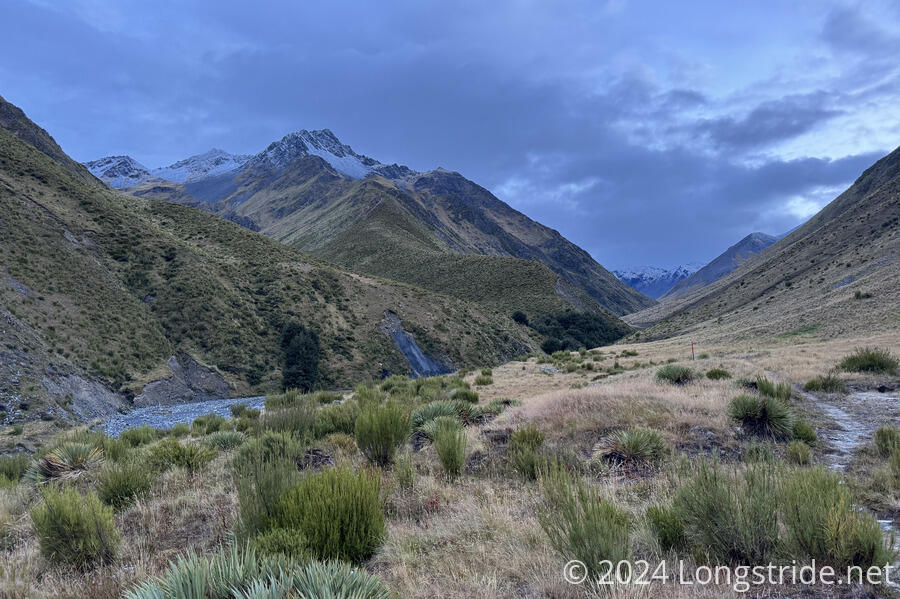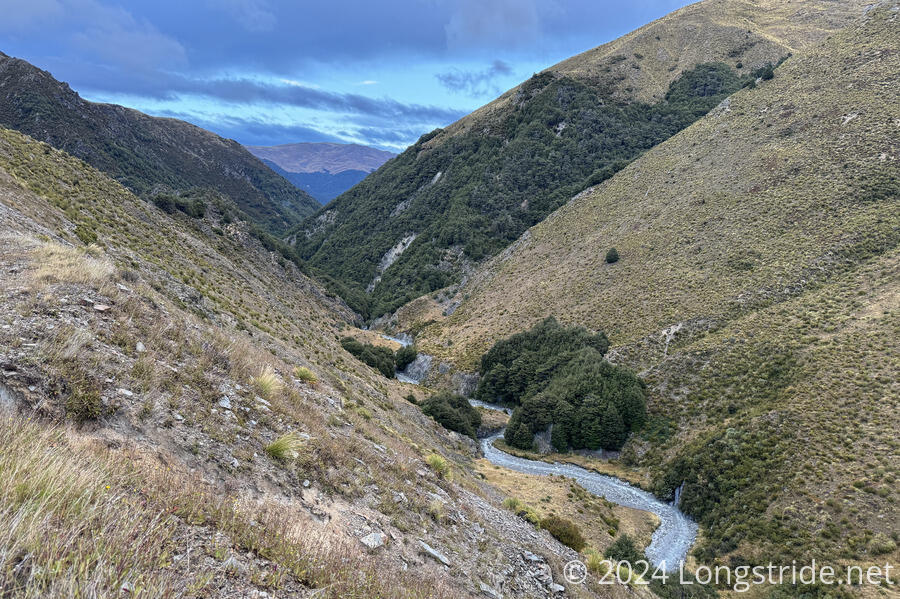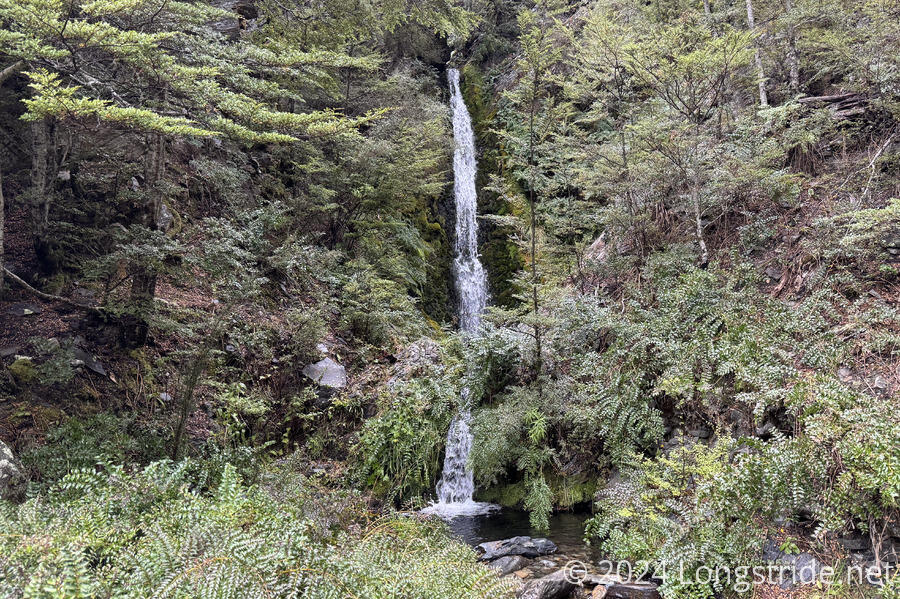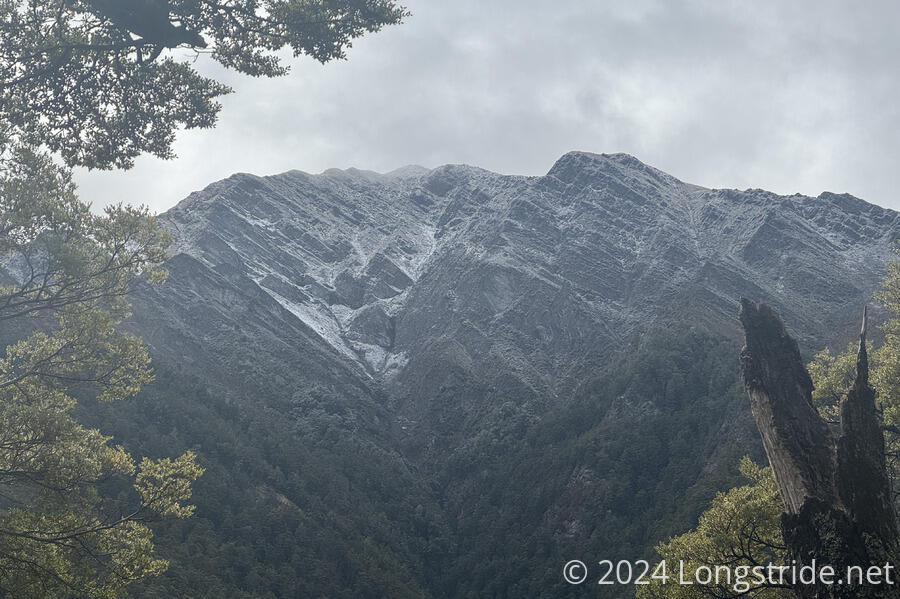A wet, cold, and very eventful day along (and through) the Timaru River brought me to an historic hut.
It rained a little bit overnight, enough to dust the nearby mountaintops with snow. I hoped that wouldn’t cause problems with the river. For the bulk of the day, the trail traverses a steep and rugged high-water trail above the Timaru River. But, when the river is in low flow, it is an option to instead just follow the riverbed downstream, which I was hoping to do to avoid a lot of unnecessary work.
I managed to leave the hut at about 7:40, earlier than usual for me, and in a rarity, I was the first to leave the hut. With the river (or ruggedness of the high-water trail), followed by a steep climb to Stodys Hut, I suspected that most everyone else would pass me at some point today, and I wanted the best opportunity to have a bunk.
Being down one trekking pole didn’t help my speed at all. I expected that I’d probably pull it out and start using it as soon as I got to a water crossing, even though that would damage the aluminum shaft replacement pole tips would go on. I didn’t last that long. Shortly after leaving the hut, the trail went through a forest on the steep side of a hill. While I was able to traverse most of it fine, I eventually reached a point where I decided that the damage to the tip-less pole was acceptable for the safety (and speed) it provided me. (And, I have new poles waiting for me in Wānaka in a couple of days, anyways.)
Once I got better views of the river, it appeared a bit cloudier than it did yesterday, when (at least it is my recollection that) it was flowing clear. This didn’t bode well for having to hike through the river, but the real questions were, how deep was it, and what was the flow rate, and I couldn’t answer those until the trail brought me down to river level.
After climbing over a large tree lying over the trail, my water bottle flew out of its pouch. Fortunately, I was in a forest, and the trees stopped it from going very far. While I was retrieving it, Masako passed me.
Later, once the trail finally reached the Timaru River, Jill and Steve, an older couple, caught up with me. We walked the next bit together, crisscrossing the river several times. We departed the river after about half a hour; the trail notes said that there was one section of the river that was not possible to hike through, but neglected to actually mention where that was, and we didn’t want to push our luck too far and have to backtrack. We suspected that the impassable section was probably at the waterfall that was noted on our maps.
I left them behind when they stopped for morning tea. A couple of minutes later, Mikkel and Isabella passed when i stopped for a moment. They were fast; I couldn’t keep up, even on the relatively nice trail at that point; once the trail got a little more rugged, I lost them in the woods.
The waterfall, it turned out, was a long, multi-cascade waterfall from a side creek that flowed into the Timaru, and not on the river itself.
Back in the woods, a dry patch on the ground in a flat area suggested someone had tented here last night.
Shortly after, I lost the tip on my other trekking pole. I spent about five minutes looking around for it where it had likely come off, before deciding it had probably pulled off in the mud and I was never going to find it. Good thing I have two new poles waiting for me in Wānaka…
A very light drizzle started while I was in the forest. A few minutes later, I again was at the river to cross it. My trail guide suggested that this was the point from where walking the river downstream was possible. The Timaru was still at a fairly low flow and not deep at all, and I decided to follow the river, rather than the high-water route. Since I’d be out in the open, I put on my rain jacket to keep my shirt dry (and me warmer).
This was not as simple as I was expecting it to be. Often there was a (usually rocky) bank on one side or the other of the river, so I didn’t have to constantly walk in the water. (Which was good, because the water was cold, and it wasn’t exactly warm out, what with the sun hidden and it drizzling.) But there were also a large number of cascades that needed navigating. Sometimes that was via the riverbank. Other times, I had to walk down rocks, or step into the pools at the bottom of the cascades and cross the river from there. Fortunately, these pools were usually not deeper than my knees, and rarely ever deeper than the bottom of my shorts.
This wasn’t fast, but it was less physically strenuous than the trail would have been. It was mentally challenging, though, because of the weather. If it had been a bright warm sunny day, the river travel would have been quite refreshing. Now, though, it was physically and mentally draining.
After a little more than an hour in the river, I misjudged the depth of a pool. I stepped in, and went deeper than I was expecting — up to my crotch — which would have been fine, except that with the water from the cascade pushing at me, I slipped and fell backwards, getting completely submerged.
It was probably only a second or two of thrashing around before I regained my footing, and a quick spot check showed that I hadn’t lost anything (a minor miracle), but now I was completely wet and cold.
I made the decision that I’d take the high-water route the next time it came down to the river, but in the meantime, I had to keep moving, because I was wet and cold and that was the only way I was going to warm up. (Well, I could have stopped to take of my wet clothes and put on dry clothes, but my dry clothes were at the very bottom of my pack, and I didn’t want to stop long enough dig everything out. I also didn’t want the answer to the question, “Just how wet did everything in my pack get?”.)
I trudged on down the river, occasionally led astray by things that looked like trails but weren’t, until I saw an orange triangle across the river. That led me back to the high-water trail, and I followed that until I reached the junction to Stodys Hut.
Now safely away from the river, I stopped for a much-needed break, now over five hours after I left the hut this morning. I lowered my pack cover (which I’d put on before leaving Top Timaru Hut this morning because it was supposed to rain) and was surprised to find that my pack brain was not terribly damp, and everything inside was dry. I still refused to look inside my pack; knowing just how wet everything inside was (or wasn’t) wouldn’t do me any good right now.
My clothes had dried a little bit, but once I ate some food, I warmed up enough to stop shivering. The sun came out briefly a few times, which also helped. All I had to do now was climb up a hill for two hours; that would definitely warm me up.
As I climbed up the side of a mountain, I was able to see the mountain across the river, which now had snow about its peak that wasn’t there before.
The trail was steep, and occasionally not well marked; I got off-trail once because an old trail hadn’t been sufficiently scuttled, and I couldn’t see a marker cairn from where I was standing at the “junction”.
As I neared Stodys Hut, I saw snow on the ground. It didn’t feel like it was freezing outside, but it couldn’t have been much warmer than that. So while it hasn’t actually snowed on me yet, this is my first snow on the TA. There were a few largeish patches of snow around the hut, but the hut itself was clear.
Once I got to the hut, I was surprised to find that only Isabella and Masako were there. Mikkel had gone on ahead to the next hut, and everyone else was behind. I was quite sure that I’d wind up being last to the hut, but instead, I was roughly in the middle of the pack. (Jill and Steve, and Nikki and James arrived quite a bit later.)
Isabella said that when she arrived at the hut two hours earlier, it was actually snowing. She was disappointed by how much had already melted.
Actually being at the hut meant that it was now time to find out how wet the stuff in my pack was. I was dreading this, because I had clothes (my fleece, pants legs, and a set of socks) stuffed in my pack for easy access, rather than stowed in my clothes bag.
It turned out that the contents of my pack was essentially completely dry. Only my clothes and sleeping bag sacks had water on them, and while a little water had seeped into my clothes bag, my clothes and sleeping bag were dry. I can only assume that my pack was underwater for such a short time that my pack cover was able to keep the river out of my pack. Either way, I was quite grateful; all of my other stuff sacks have holes in them, and if the river had gotten inside my pack — and especially into my electronics bag — it could have been very bad.
I changed clothes, cooked diner, and retreated into my sleeping bag much earlier than usual. The hut was cold. A historic sheep musters hut, with a dirt floor, there was basically no insulation to speak of, and the walls had numerous small holes. The hut had a fireplace, with plenty of firewood, and I would have been very happy to have a fire to dry my clothes out (and warm us all up), but no one seemed willing to volunteer to manage the fire, so instead, we were all cold.
I contacted CareFree with my InReach to book a room for me in Lake Hāwea tomorrow (because Lake Hāwea and Wānaka are busy tourist towns), but by that time, the reception of the place I’d picked had closed. She’ll try again tomorrow morning, and hopefully I’ll actually have cell reception to be able work out a place to stay in Wānaka the day after — for two nights: it’s time for a zero.



